Abstract
Since the working environment act was passed in 1991, employers in Sweden are toplan and control the working environment conditions in workplaces. They are responsible for organized rehabilitation at the workplace including the development of rehabilitation plans and a plan for interventions in order for a sick-listed client to be able to return to work. The aim of this study was to describe employers' experiences of how motivation can be improved in a work rehabilitation process. Qualitative interviews were performed with 10 employers who had employees that had taken part in a period of vocational rehabilitation at a rehabilitation center in the north of Sweden, over a 2-year period. The result showed that increased focus on motivation for change is needed in work rehabilitation. The clients' motivation for change could be improved by a focus on motivational conversations at the workplace aiming at motivation for change in their working and living conditions. The employers' power of initiative, competence, economic resources, and motivation are needed for creative solutions at the workplace.
Similar content being viewed by others
REFERENCES
Government Bill 1990:91:140. Working environment and rehabilitation (in Swedish). Stockholm: The Government, 1990.
SoS-report No.: 1993:10. Rehabilitation within health care, for all ages and diagnoses (in Swedish). Stockholm: The National Board of Health and Welfare, the Federation of County Councils, The Swedish Association of Local Authorities, 1993.
SOU Report No.: 1988:41. Early and coordinated rehabilitation–-Report of the Rehabilitation commission (in Swedish). Stockholm: Ministry of Social affairs, 1988.
Jeppsson-Grassman E. Work life demands and individual suffering (Report No. 57). Stockholm: Stockholm University, 1992.
Steers RM, Porter LW. Motivation and work behavior. New York: McGraw-Hill, 1991.
Lewthwaite R. Motivational considerations in physical activity involvement. Phys Ther 1990; 70(12): 808-819.
Geelen RJGM, Soons PHGM. Rehabilitation: An everyday motivation model. Patient Educ Couns 1996;28:69-25.
Gruninger UJ. Patient education: An example of one-to-one communication. J Hum Hypertens 1995;9:155-125.
Paulsberg AG. How do we motivate patients to activity? Omsorg 1995;2:22-23.
Grahn B. Quality of life, motivation and costs in multidisciplinary occupational rehabilitation. PhD Thesis, Department of Physical Therapy, Lund University, 1999.
Gard G, Sandberg A-C. Motivating factors for return to work. Physiother Res Int 1998; 3(2): 100-108.
Andersson SI. Appraisal, coping, motivational factors and gender in vocational rehabilitation. Scand J Soc Med 1996;24:161-168.
Gard G. Work motivating factors in rehabilitation: A brief review. Phys Ther Rev 2001;6:85-89.
Patton MQ. Qualitative evaluation and research methods. Newbury Park, CA: Sage, 1990.
Burnard P. A method of analysing interview transcripts in qualitative research. Nurs Educ Today 1991;11:461-466.
Downe-Wamboldt B. Content analysis: Method, applications, and issues. Health Care Women Int 1992;13:313-321.
Söderberg S, Lundman B. Transition experienced by women with fibromyalgia. Health Care Women Int 2001;22:617-631.
Law M, Baptiste S, Mills J. Client-centerd practice: What does it mean and does it make a difference. Can J Occup Ther 1995;62:250-257.
Duvall C. Developing freedom to act. Empowerment in the knowledge organization. Participation Empowerment Int J 1999; 7(6): 204-212.
Malone TW. Is empowerment just a fad? Sloan Manage Rev 1997; 38(2): 23-35.
McDougall T. Patient empowerment: Fact or fiction? Ment Health Nurs 1997; 17(1): 4-5.
Dannemark B, Kullberg B. Cooperation–-A new working strategy (in Swedish). Lund: Studentlitteratur, 1999.
Shaw L, Segal R, Polatajko H, and Harburn K. Understanding return to work behaviors: Promoting the importance of individual perceptions in the study of return to work. Disabil Rehabil 2002; 24(4): 185-195.
Goleman D. Emotional intelligence. New York: Bantam, 1995.
Gyllensten AL, Gard G, Salford E, Ekdahl C. Interaction between patient and physical therapist: A qualitative study reflecting the physical therapist's perspective. Physiother Res Int 1999; 4(2): 89-109.
Grape O. Between the stick and the carrot. A case study of the Rehabilitation reform of 1992 (Swedish text with a summary in English). PhD thesis, the Faculty of Social Sciences, Umeå University, 2001.
Author information
Authors and Affiliations
Rights and permissions
About this article
Cite this article
Gard, G., Larsson, A. Focus on Motivation in the Work Rehabilitation Planning Process: A Qualitative Study from the Employer's Perspective. J Occup Rehabil 13, 159–167 (2003). https://doi.org/10.1023/A:1024901201414
Issue Date:
DOI: https://doi.org/10.1023/A:1024901201414




